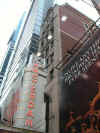 |
New York
Architecture Images- Midtown New Amsterdam Theater |
|
architect |
Herts & Tallant |
|
location |
214 W42, bet. Seventh and Eighth Aves. |
|
date |
1903 |
|
style |
Beaux-Arts |
|
construction |
stone, brick |
|
type |
Theater |
|
|
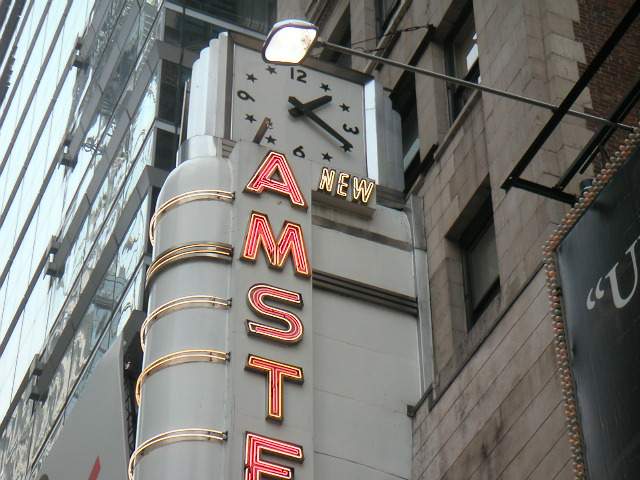 |
|
images |
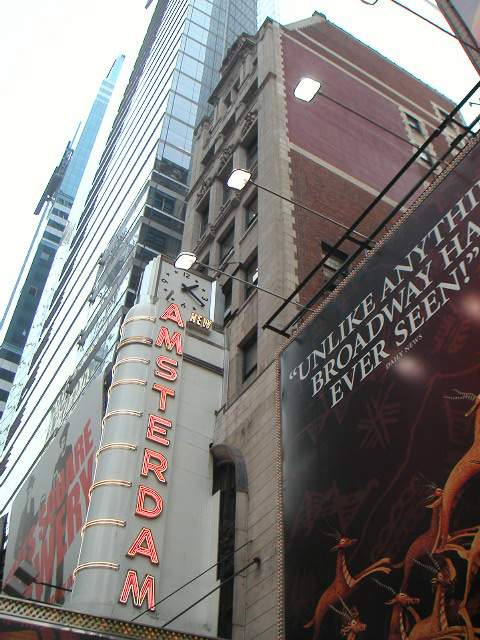 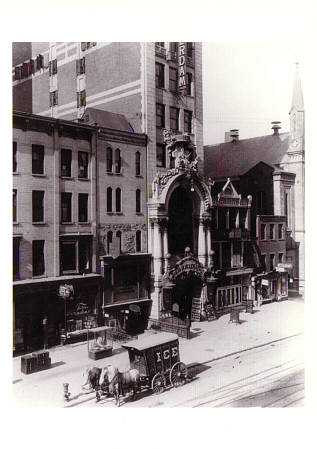 |
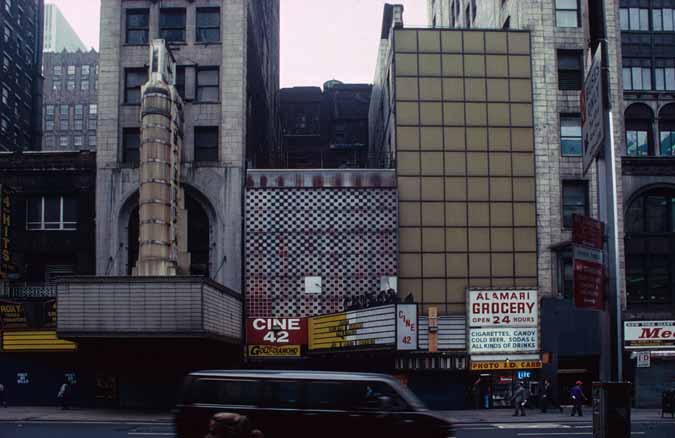 |
|
| How things have changed!!! | |
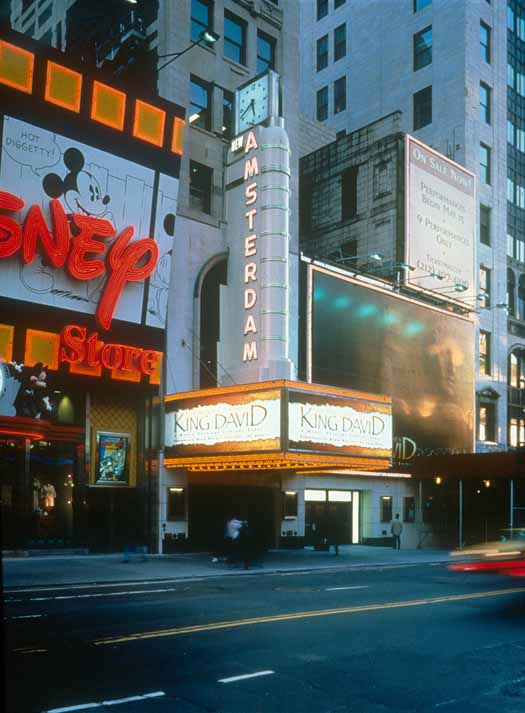 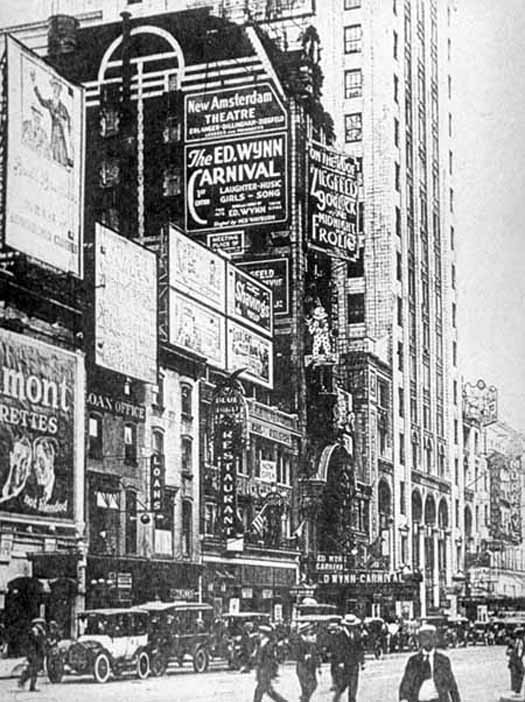 |
|
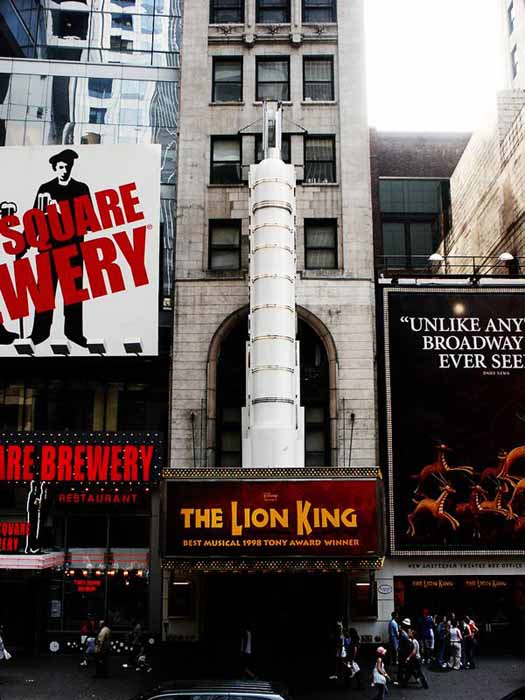 .jpg) |
|
| Image- with special thanks to Rick Stasel | |
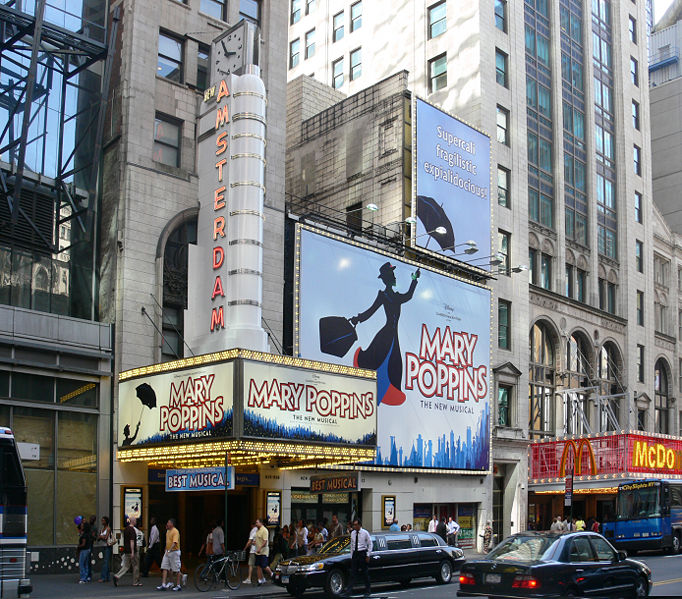 |
|
| New Amsterdam Theatre showing Mary Poppins, 2007 | |
|
The New Amsterdam Theatre is a Broadway theatre located at 214 West 42nd
Street in the heart of Times Square in New York City. It is operated by
Disney Theatrical Productions, and is currently showing the musical Mary
Poppins. History Construction and original run The New Amsterdam was built in 1903 by the partnership of impresarios A.L. Erlanger and Marcus Klaw and designed in the Art Nouveau style by architects Herts and Tallant. At the time of construction, it was the largest theatre in New York with a seating capacity of 1,702. Along with the Lyceum Theatre, also built in 1903, it is the oldest surviving Broadway venue. The New Amsterdam opened in November 1903 with a production of Shakespeare's A Midsummer Night's Dream. For many years, it hosted the Ziegfeld Follies, showcasing such talents as Olive Thomas, Fanny Brice and the Eaton siblings. A racier sister show of the Follies, the Midnight Frolics, played in the New Amsterdam's roof garden theatre. The New Amsterdam was the scene of Marilyn Miller's greatest triumphs in the musicals Sally (1920) and Sunny, which opened in September 1925 co-starring Clifton Webb as Harold Wendell-Wendell and ran for three seasons [1]. But the theatre also hosted serious productions, and in June 1927 Basil Rathbone appeared there as Cassius in Julius Caesar [2]. Restoration The Great Depression took its toll on the theatre business, and in 1936 the New Amsterdam closed. It reopened on a limited basis in 1937 but soon was converted to a movie theatre. The Nederlander Organization purchased the landmark property in 1982, but it would not be on the road to rehabilitation for another eight years. In 1990, after a court battle, the State and City of New York assumed ownership of the New Amsterdam and many other theatres on 42nd Street. Disney Theatrical Productions signed a 99 year lease for the property in 1993. The theatre, which had recently been used as a filming location for the movie Vanya on 42nd Street, was in shambles; it would take several years and millions of dollars, to restore it to its original usage and grandeur. The roof garden remained closed when it was discovered that it could not be brought up to modern building codes. The New Amsterdam was officially reopened on April 2, 1997. In November 1997, after the premiere of the film Hercules and a limited engagement of a concert version of King David, Disney's stage version of The Lion King opened. On June 4, 2006, The Lion King closed in The New Amsterdam Theatre, moving two blocks uptown to the Minskoff Theatre on June 13, 2006. Mary Poppins began previews at the New Amsterdam Theatre on October 16, 2006 and opened on November 16, 2006. [1] Benefit events The New Amsterdam has also hosted events benefitting Broadway Cares/Equity Fights AIDS, including the annual Easter Bonnet Competition. In recent years, the benefit's honored guest has been centenarian Doris Eaton Travis, who originally performed on the New Amsterdam stage in the Ziegfeld Follies of 1919. References ^ Parker, John (ed), Who's Who in the Theatre, 10th revised edition, London, 1947: 1429 ^ Parker, John (ed), Who's Who in the Theatre, 10th revised edition, London, 1947: 1184 |
|
|
Built 1903 by Herts & Tallant for Klaw and Erlanger.
Opened 26 Oct 1903 with Shakespeare's "A Midsummer Nights Dream". Home
to the "Ziegfeld Follies" from 1913 until 1927. In the 1940s converted
to a cinema. 1994-1997 renovation for Walt Disney Co. Re-opened May 1997
with a concert performance of "King David". Since 1997, used for the
musical, "The Lion King". 1771 seats.
Roof theatre: Opened 1904 as "Aerial Gardens" (693 seats). 1914 renamed "Danse de Follies". 1923 renamed "Frolic Theatre". Special thanks to CARTHALIA Andreas Praefcke's postcard collection of theatres. |
|
|
Along with the New Victory, Lyceum and Hudson theaters one of the oldest surviving legitimate theaters on Broadway. In 1902 impresarios Marc Klaw and Abraham Erlanger followed Oscar Hammerstein to 42nd Street. But just barely. The theater they commissioned Herts & Tallant to build across from Hammerstein's Republic has a narrow entry on 42nd Street with, the bulk of the house on 41st Street. The 42nd Street Beaux-Arts entrance opens into the finest Art Nouveau theater interiors in NYC. Carved and painted plaster, carved stone, carved wood, murals and tiles—all combine to evoke what it was like going to the theater at the turn of the century. A production of Shakespeare's Midsummer Nights Dream opened the theater on Nov 2, 1903. Florenz Ziegfeld staged his Follies at the New Amsterdam from 1913 through 1927, along with various editions of his other revues, known under various names including The Midnight Frolic and The Nine O'Clock Revue, on the theater's rooftop stage As were many other legitimate theaters during the Depression years, the New Amsterdam was converted to a movie house in 1937. The Nederlander Organization purchased the theater in 1982 and, planning to piggyback on the proposed redevelopment of the Times Square area, started on a problem plagued reconstruction program to return the theater to legitimate use. Major structural problems, combined with the uncertainty of the City's economic health (which had the Times Square redevelopment project in fits and starts), repeatedly delayed the reconstruction. New York State purchased the New Amsterdam in 1992 and subsequently resold it to the Walt Disney Co for $29 million. The complete reconstruction of the theater between 1995 - 1997 signaled Disney's confidence in Times Square and anchored the further redevelopment of the area 1906 Victor Moore, Fay Templeton and Donald Brian star in Forty-five Minutes from Broadway, with a book by George M Cohan, music by George M Cohan and lyrics by George M Cohan. George M Cohan did not star 1907 A production of Franz Lehar's The Merry Widow runs for 416 performances 1910 The Otto Harbach-Karl Hoschna musical Madame Sherry runs for 231 performances and stars Jack Gardner, Ralph Herz and Lina Arbarbanell 1911 Hazel Dawn is The Pink Lady in her Broadway debut. The show, with music by Ivan Caryl and lyrics by CMS McLellan runs for 312 performances 1913 Flo Ziegfeld produces the first of his Follies revues at the New Amsterdam. This installment features Leon Errol, Frank Tinney and Ann Pennington 1913 Victor Herbert's musical Sweethearts stars Christie MacDonald 1914 Ziegfeld's Follies are back along with Leon Errol and Ann Pennington, this time joined by Bert Williams and Ed Wynn, in his very first Follies 1914 The great husband and wife dance team Vernon and Irene Castle make their last Broadway appearance in Irving Berlin's first musical Watch Your Step 1915 to 1920 Ziegfeld starts his Midnight Frolics on the rooftop stage of the New Amsterdam in 1915. Ziegfeld's Follies fly high through the late teens, with performers such as Bert Williams, Ed Wynn, May Murray, George White, Leon Errol, Fanny Brice, Theda Bara, Ina Claire, Ann Pennington and Lillian Lorraine sharing the bill. WC Fields makes his Follies debut in 1915, Will Rogers makes his in 1916, Eddie Cantor in 1917 and Marilyn Miller bows in 1918. After Prohibition goes into effect in 1920, the Midnight Frolics, which depended on after-theater drink sales, become the Nine O'Clock Revue, a show sustained by admission charges 1920 Ed Wynn stars in a revue of his own, The Ed Wynn Carnival, with Marion Davis 1920 Marilyn Miller, Leon Errol, Walter Catlett and Helen Morgan star in the Guy Bolton-Jerome Kern musical Sally. The show runs for 570 performances 1925 Otto Harbach, Oscar Hammerstein II and Jerome Kern collaborate on the musical Sunny. The show stars Marilyn Miller and Clifton Webb. A young Pert Kelton has a bit part; in the 50s she becomes not at all well-known as Alice Cramden in the first few episodes of the Honeymooners, later replaced by Audrey Meadow 1928 Sigmund Romberg and the Gershwin brother's combine for the musical Rosalie, starring Marilyn Miller, Jack Donahue and Frank Morgan 1931 Fred Astaire is in on his way out to Hollywood and The Band Wagon is his and sister Adele's last show together 1932 Even the best have a dry spell. Irving Berlin has not had a show on Broadway in 5 years. Face the Music has a book by Moss Hart, is directed by George S Kaufman and stars Mary Boland. It limps through 165 performances 1933 The Otto Harbach-Jerome Kern musical Roberta stars Bob Hope, Tamara Drasin, Sidney Greenstreet, Fay Templeton and George Murphy 1997 After a 60-year hiatus, the New Amsterdam reopens as a legitimate venue with a musical production of King David 1998 Destined for a long run delighting children of all ages, The Lion King opens to glowing reviews and glowing audiences. Critics doubted the Disney organization had the right stuff for Broadway, but the show takes the Tony for best musical, as do Julie Taymor for direction and Garth Fagan for choreography 2003 This show doesn't stop With thanks to http://www.jimsdeli.com |
|
|
Purchased and restored by the Walt Disney Company in 1995-97, the New Amsterdam Theatre was the centerpiece of the recent Times Square revival. Beautifully restored, the New Amsterdam Theater is now Disney's premiere showcase for its stage shows. Tours are given on Mondays and Tuesdays and the cats from Lion King will seemingly play here forever. 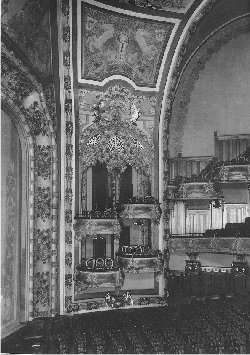 Seats 1,771 people Neighborhood: Theatre District Location: South side of 42nd Street, west of 7th Avenue; right next to The Disney Store
Broadway's newest legit house is really its oldest: the original New
Amsterdam opened in 1903 (the same night as the Lyceum). The New
Amsterdam theatre was built by Klaw and Erlanger. Its elaborate
decor was a collaboration of many painters, sculptors, and designers.
Decorated in mauve, green and dull gold, the beauty of the theatre
earned its name "The House Beautiful" from the New York Times
upon its opening. Three motifs were used in the decoration:
the history of New Amsterdam from Henrick Hudson to 1903, the history of
the theatre, and art nouveau floral and fauna. To see before and after pictures of the renovation click here. |
|
| links | New
Amsterdam Theatre at the
Internet
Broadway Database Official Website Broadway Theatre Guide with full show details for the New Amsterdam Theatre Chronology at the New 42nd Street site Henderson, Mary C. (1997). The New Amsterdam: The Biography of a Broadway Theatre. New York: Hyperion. ISBN 0-7868-6270-X. Morrison, William (1999). Broadway Theatres: History and Architecture. Mineola, N.Y.: Dover Publications. ISBN 0-486-40244-4. Travis, Doris Eaton; with Joseph and Charles Eaton (2003). The Days We Danced: The Story of My Theatrical Family from Florenz Ziegfeld to Arthur Murray and Beyond. Seattle: Marquand Books. ISBN 0-8061-9950-4. |